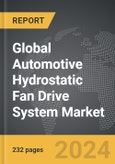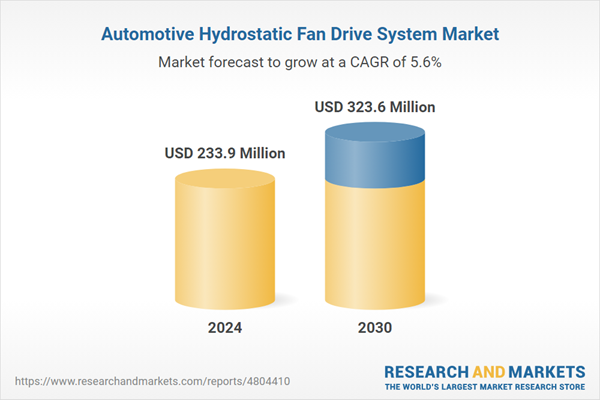The global market for Automotive Hydrostatic Fan Drive System was valued at US$233.9 Million in 2024 and is projected to reach US$323.6 Million by 2030, growing at a CAGR of 5.6% from 2024 to 2030. This comprehensive report provides an in-depth analysis of market trends, drivers, and forecasts, helping you make informed business decisions. The report includes the most recent global tariff developments and how they impact the Automotive Hydrostatic Fan Drive System market.
Segments: Vehicle Type (Construction Equipment, Buses, Agricultural Tractors).
Geographic Regions/Countries: World; United States; Canada; Japan; China; Europe (France; Germany; Italy; United Kingdom; Spain; Russia; and Rest of Europe); Asia-Pacific (Australia; India; South Korea; and Rest of Asia-Pacific); Latin America (Argentina; Brazil; Mexico; and Rest of Latin America); Middle East (Iran; Israel; Saudi Arabia; United Arab Emirates; and Rest of Middle East); and Africa.
The analysts continuously track trade developments worldwide, drawing insights from leading global economists and over 200 industry and policy institutions, including think tanks, trade organizations, and national economic advisory bodies. This intelligence is integrated into forecasting models to provide timely, data-driven analysis of emerging risks and opportunities.
Global Automotive Hydrostatic Fan Drive System Market - Key Trends and Drivers Summarized
How Does the Automotive Hydrostatic Fan Drive System Work and What Are Its Core Components?
The automotive hydrostatic fan drive system plays a crucial role in managing the thermal efficiency of heavy-duty vehicles, particularly in off-highway applications like construction and agricultural machinery. At its core, the system operates by converting mechanical energy from the engine into hydraulic energy, which is then used to drive the cooling fan independently of the engine speed. This independence allows for more precise control over the fan's speed, optimizing engine cooling based on the actual thermal needs rather than being directly tied to the engine's RPM. The primary components of a hydrostatic fan drive system include a hydraulic pump, usually driven by the engine, a hydraulic motor that drives the fan, control valves, and sensors that monitor engine temperature. The system’s ability to modulate fan speed not only improves engine efficiency but also reduces noise and fuel consumption, which are significant benefits in the context of heavy-duty vehicle operation. This technology has become increasingly indispensable as vehicles are required to operate efficiently under varying environmental and load conditions.What Are the Applications and Benefits of Hydrostatic Fan Drive Systems in the Automotive Industry?
Automotive hydrostatic fan drive systems are predominantly used in vehicles that operate under harsh conditions and require robust cooling solutions, such as construction equipment, agricultural machinery, and heavy trucks. These systems are particularly valued for their ability to provide efficient and reliable cooling, even when vehicles are idling or operating at low speeds, where traditional mechanical fan drives are less effective. In addition to enhancing cooling efficiency, hydrostatic fan drives contribute to improved fuel economy and reduced emissions, as the fan only operates when necessary and at the optimal speed. This is critical for meeting increasingly stringent environmental regulations. Furthermore, the system’s flexibility in placement within the vehicle allows for better overall vehicle design, as the fan drive can be positioned independently of the engine. This capability is especially important in modern vehicle designs, where space constraints and weight distribution are critical considerations. The application of hydrostatic fan drive systems, therefore, extends beyond simple cooling, providing a holistic solution that contributes to the overall efficiency and sustainability of heavy-duty vehicles.How Is Technology Shaping the Evolution of Hydrostatic Fan Drive Systems?
Technological advancements are driving significant changes in the design and functionality of automotive hydrostatic fan drive systems. Innovations in hydraulic pump and motor technologies, such as the development of variable displacement pumps, have enabled more precise control of fan speed, further improving system efficiency. Additionally, advancements in electronic control systems have allowed for the integration of intelligent fan drive management, where fan operation is dynamically adjusted based on real-time data from temperature sensors and engine load conditions. This level of control not only enhances cooling performance but also reduces unnecessary energy consumption, aligning with the broader industry trend toward energy efficiency and sustainability. Moreover, improvements in hydraulic fluid technology, including the development of fluids with better thermal stability and lower viscosity, have increased the longevity and reliability of hydrostatic fan drive systems. These technological innovations are making hydrostatic fan drives more attractive in a wider range of applications, including hybrid and electric vehicles, where thermal management is critical to maintaining battery life and overall vehicle performance.What Are the Growth Drivers in the Automotive Hydrostatic Fan Drive System Market?
The growth in the automotive hydrostatic fan drive system market is driven by several factors that are reshaping the landscape of the automotive and heavy machinery industries. One of the primary drivers is the increasing demand for fuel efficiency and emission reduction in heavy-duty vehicles, which is pushing manufacturers to adopt more efficient cooling solutions like hydrostatic fan drives. The rising adoption of advanced driver-assistance systems (ADAS) and autonomous vehicle technologies, particularly in off-highway applications, is also spurring demand for sophisticated cooling systems that can operate independently of engine speed, ensuring optimal performance under all operating conditions. Furthermore, the expansion of the construction and agricultural machinery markets in emerging economies is creating a growing need for reliable and efficient cooling systems, further propelling the adoption of hydrostatic fan drives. The trend toward vehicle electrification and hybridization is another significant driver, as these vehicles require advanced thermal management solutions to maintain battery performance and overall system efficiency. Additionally, the push for sustainability and the need to meet stringent environmental regulations are encouraging manufacturers to invest in hydrostatic fan drive systems, which offer a compelling combination of efficiency, reliability, and environmental benefits. These factors collectively ensure that the market for automotive hydrostatic fan drive systems remains dynamic and poised for continued growth in the coming years.Report Scope
The report analyzes the Automotive Hydrostatic Fan Drive System market, presented in terms of units. The analysis covers the key segments and geographic regions outlined below.Segments: Vehicle Type (Construction Equipment, Buses, Agricultural Tractors).
Geographic Regions/Countries: World; United States; Canada; Japan; China; Europe (France; Germany; Italy; United Kingdom; Spain; Russia; and Rest of Europe); Asia-Pacific (Australia; India; South Korea; and Rest of Asia-Pacific); Latin America (Argentina; Brazil; Mexico; and Rest of Latin America); Middle East (Iran; Israel; Saudi Arabia; United Arab Emirates; and Rest of Middle East); and Africa.
Key Insights:
- Market Growth: Understand the significant growth trajectory of the Construction Equipment segment, which is expected to reach US$154.6 Million by 2030 with a CAGR of a 6.1%. The Buses segment is also set to grow at 5.1% CAGR over the analysis period.
- Regional Analysis: Gain insights into the U.S. market, valued at $61.1 Million in 2024, and China, forecasted to grow at an impressive 8.3% CAGR to reach $73.2 Million by 2030. Discover growth trends in other key regions, including Japan, Canada, Germany, and the Asia-Pacific.
Why You Should Buy This Report:
- Detailed Market Analysis: Access a thorough analysis of the Global Automotive Hydrostatic Fan Drive System Market, covering all major geographic regions and market segments.
- Competitive Insights: Get an overview of the competitive landscape, including the market presence of major players across different geographies.
- Future Trends and Drivers: Understand the key trends and drivers shaping the future of the Global Automotive Hydrostatic Fan Drive System Market.
- Actionable Insights: Benefit from actionable insights that can help you identify new revenue opportunities and make strategic business decisions.
Key Questions Answered:
- How is the Global Automotive Hydrostatic Fan Drive System Market expected to evolve by 2030?
- What are the main drivers and restraints affecting the market?
- Which market segments will grow the most over the forecast period?
- How will market shares for different regions and segments change by 2030?
- Who are the leading players in the market, and what are their prospects?
Report Features:
- Comprehensive Market Data: Independent analysis of annual sales and market forecasts in US$ Million from 2024 to 2030.
- In-Depth Regional Analysis: Detailed insights into key markets, including the U.S., China, Japan, Canada, Europe, Asia-Pacific, Latin America, Middle East, and Africa.
- Company Profiles: Coverage of players such as Avid Impex Pvt. Ltd., Axiomatic Technologies Corporation, Bondioli & Pavesi SpA, Bosch Rexroth AG, Bucher Hydraulics GmbH and more.
- Complimentary Updates: Receive free report updates for one year to keep you informed of the latest market developments.
Some of the 13 companies featured in this Automotive Hydrostatic Fan Drive System market report include:
- Avid Impex Pvt. Ltd.
- Axiomatic Technologies Corporation
- Bondioli & Pavesi SpA
- Bosch Rexroth AG
- Bucher Hydraulics GmbH
- Casappa SpA
- Concentric AB
- Danfoss A/S
- Eaton Corporation PLC
- Enovation Controls
- HAWE Hydraulik SE
- Hydac International GmbH
- Hydraforce Hydraulics
- Hydrosila JSC
- JTEKT Corporation
- Parker Hannifin Corporation
- Quality Hydraulics & Pneumatics, Inc.
- Walvoil S.p.A.
Tariff Impact Analysis: Key Insights for 2025
Global tariff negotiations across 180+ countries are reshaping supply chains, costs, and competitiveness. This report reflects the latest developments as of April 2025 and incorporates forward-looking insights into the market outlook.The analysts continuously track trade developments worldwide, drawing insights from leading global economists and over 200 industry and policy institutions, including think tanks, trade organizations, and national economic advisory bodies. This intelligence is integrated into forecasting models to provide timely, data-driven analysis of emerging risks and opportunities.
What’s Included in This Edition:
- Tariff-adjusted market forecasts by region and segment
- Analysis of cost and supply chain implications by sourcing and trade exposure
- Strategic insights into geographic shifts
Buyers receive a free July 2025 update with:
- Finalized tariff impacts and new trade agreement effects
- Updated projections reflecting global sourcing and cost shifts
- Expanded country-specific coverage across the industry
Table of Contents
I. METHODOLOGYII. EXECUTIVE SUMMARY2. FOCUS ON SELECT PLAYERSIII. MARKET ANALYSISSOUTH KOREAREST OF ASIA-PACIFICARGENTINABRAZILMEXICOREST OF LATIN AMERICAIRANISRAELSAUDI ARABIAUNITED ARAB EMIRATESREST OF MIDDLE EASTIV. COMPETITION
1. MARKET OVERVIEW
3. MARKET TRENDS & DRIVERS
4. GLOBAL MARKET PERSPECTIVE
UNITED STATES
CANADA
JAPAN
CHINA
EUROPE
FRANCE
GERMANY
ITALY
UNITED KINGDOM
SPAIN
RUSSIA
REST OF EUROPE
ASIA-PACIFIC
AUSTRALIA
INDIA
LATIN AMERICA
MIDDLE EAST
AFRICA
Companies Mentioned (Partial List)
A selection of companies mentioned in this report includes, but is not limited to:
- Avid Impex Pvt. Ltd.
- Axiomatic Technologies Corporation
- Bondioli & Pavesi SpA
- Bosch Rexroth AG
- Bucher Hydraulics GmbH
- Casappa SpA
- Concentric AB
- Danfoss A/S
- Eaton Corporation PLC
- Enovation Controls
- HAWE Hydraulik SE
- Hydac International GmbH
- Hydraforce Hydraulics
- Hydrosila JSC
- JTEKT Corporation
- Parker Hannifin Corporation
- Quality Hydraulics & Pneumatics, Inc.
- Walvoil S.p.A.
Table Information
| Report Attribute | Details |
|---|---|
| No. of Pages | 232 |
| Published | April 2025 |
| Forecast Period | 2024 - 2030 |
| Estimated Market Value ( USD | $ 233.9 Million |
| Forecasted Market Value ( USD | $ 323.6 Million |
| Compound Annual Growth Rate | 5.6% |
| Regions Covered | Global |









